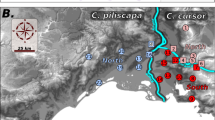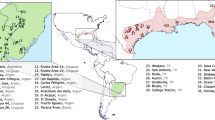Abstract
In this paper, we examine the hypothesis that reduced intraspecific aggression underlies the competitive prowess of Argentine ants in their introduced range. Specifically, we test three predictions of this hypothesis by comparing the genetic diversity, behavior, and ecology of Argentine ants in their native range to introduced populations. Differences between native and introduced populations of Argentine ants were consistent with our predictions. Introduced populations of the Argentine ant appear to have experienced a population bottleneck at the time of introduction, as evidenced by much reduced variation in polymorphic microsatellite DNA markers. Intraspecific aggression was rare in introduced populations but was common in native populations. Finally, in contrast to the Argentine ant's ecological dominance throughout its introduced range, it did not appear dominant in the native ant assemblages studied in Argentina. Together these results identify a possible mechanism for the widespread success of the Argentine ant in its introduced range.
Similar content being viewed by others
References
Adams ES (1990) Boundary disputes in the territorial ant Azteca trigona: effects of asymmetries in colony size. Animal Behavior 39: 321–328
Allen CR, Lutz RS and Demorais S (1995) Red imported fire ant impacts on northern bobwhite populations. Ecological Applications 5: 632–638
Berlocher SH (1984) Genetic changes coinciding with the colonization of California by the walnut husk fly, Rhagoletis completa. Evolution 38: 906–918
Bond W and Slingsby P (1984) Collapse of an ant-plant mutualism: the Argentine ant (Iridomyrmex humilis) and myrmecochorous Proteaceae. Ecology 65: 1031–1037
Bourke AFG and Franks NR (1995) Social Evolution in Ants. Princeton University Press, Princeton, NJ
Cammel ME, Way MJ and Paiva MR (1996) Diversity and structure of ant communities associated with oak, pine, eucalyptus and arable habitats in Portugal. Insectes Sociaux 43: 37–46
Clark DB, Guayasamín C, Pazmiño O, Donoso C and de Villacís YP (1982) The tramp ant Wasmannia auropunctata: autecology and effects on ant diversity and distribution on Santa Cruz island, Galapagos. Biotropica 14: 196–207
Cole FR, Medeiros AC, Loope LL and Zuehlke WW (1992) Effects of the Argentine ant on arthropod fauna of Hawaiian high-elevation shrubland. Ecology 73: 1313–1322
Crowell KL (1968) Rates of competitive exclusion by the Argentine ant in Bermuda. Ecology 49: 551–555
De Kock AE and Giliomee JH (1989) A survey of the Argentine ant, Iridomyrmex humilis (Mayr), (Hymenoptera, Formicidae) in south African fynbos. Journal of the Entomological Society of Southern Africa 52: 157–164
Eckert CG, Manicacci D and Barrett SCH (1996) Genetic drift and founder effect in native versus introduced populations of an invading plant, Lythrum salicaria (Lythraceae). Evolution 50: 1512–1519
Elton CS (1958) The Ecology of Invasions. John Wiley, New York
Erickson JM (1971) The displacement of native ant species by the introduced Argentine ant Iridomyrmex humilis (Mayr). Psyche 257–266
Feener DH Jr (1981) Competition between ant species: outcome controlled by parasitic flies. Science 214: 815–817
Feener DH Jr and Brown BV (1997) Diptera as parasitoids. Annual Review of Entomology 42: 73–97
Fuentes ER (1991) Central Chile: how do introduced plants and animals fit into the landscape. In: Groves RH and Di Castri F (eds) Biogeography of Mediterranean Invasions, pp 43–49. Cambridge University Press, Cambridge, UK
Hölldobler B and Lumsden CJ (1980) Territorial strategies in ants. Science 210: 732–739
Hölldobler B and Michener CD (1980) Mechanisms of identification and discrimination in social Hymenoptera. In: Markl H (ed) Evolution of Social Behavior: Hypotheses and Empirical Tests, pp 35–37. Verlag Chemie, Weinheim
Hölldobler B and Wilson EO (1977) The number of queens: an important trait in ant evolution. Naturwissenschaften 64: 8–15
Hölldobler B and Wilson EO (1990) The Ants. Belknap Press, Harvard University Press, Cambridge, MA
Holway DA (1998a) Effects of Argentine ant invasions on ground-dwelling arthropods in northern California riparian woodlands. Oecologia 116: 252–258
Holway DA (1998b) Factors governing rate of invasion: a natural experiment using Argentine ants. Oecologia 115: 206–212
Holway DA (1999) Competitive mechanism underlying the displacement of native ants by the invasive Argentine ant. Ecology 80: 238–251
Holway DA, Suarez AV and Case TJ (1998) Loss of intraspecific aggression in the success of a widespread invasive social insect. Science 282: 949–952
Human KG and Gordon DM (1996) Exploitation and interference competition between the invasive Argentine ant, Linepithema humile, and native ant species. Oecologia 105: 405–412
Keller L and Passera L (1989) Influence of the number of queens on nest-mate recognition and attractiveness of queens to workers in the Argentine ant, Iridomyrmex humilis (Mayr). Animal Behavior 37: 733–740
Knight RL and Rust MK (1990) The urban ants of California with distributional notes of imported species. Southwestern Entomologist 15: 167–178
Macom TE and Porter SD (1996) Comparison of polygyne and monogyne red imported fire ant (Hymenoptera: Formicidae) population densities. Annals of the Entomological Society of America 89: 535–543
Majer JD (1994) Spread of Argentine ants (Linepithema humile), with special reference to Western Australia. In: Williams DF (ed) Exotic Ants: Biology, Impact, and Control of Introduced Species, pp 163–173. Westview Press, Boulder, CO
Markin GP (1968) Nest relationship of the Argentine ant, Iridomyrmex humilis (Hymenoptera: Formicidae). Journal of the Kansas Entomological Society 41: 511–516
Markin GP (1970) The seasonal life cycle of the Argentine ant, Iridomyrmex humilis (Hymenoptera: Formicidae) in southern California. Annals of the Entomological Society of America 63: 1238–1242
Mount RH (1981) The red imported fire ant, Solenopsis invicta (Hymenoptera: Formicidae), as a possible serious predator on some native southeastern vertebrates: direct observations and subjective impressions. Journal of the Alabama Academy of Sciences 52: 71–78
Nei M (1987) Molecular Evolutionary Genetics. Columbia University Press, New York
Newell W and Barber TC (1913) The Argentine ant. United States Department of Agriculture Bureau of Entomology Bulletin 122, 98 pp
Orians GH (1986) Site characteristics favoring invasions. In: Mooney HA and Drake JA (eds) Ecology of Biological Invasions of North America and Hawaii, Ecological Studies 58, pp 133–145. Springer-Verlag, New York
Orr MR, Seike SH, Benson WW and Gilbert LE (1995) Flies suppress fire ants. Nature 373: 292–293
Orr MR, Seike SH and Gilbert LE (1997) Foraging ecology and patterns of diversification in dipteran parasitoids of fire ants in south Brazil. Ecological Entomology 22: 305–314
Orr MR and Seike SH (1998) Parasitic flies (Diptera: Phoridae) alter the foraging success of Argentine ants (Linepithema humile) in their native habitat in Brazil. Oecologia 417: 420–425
Passera L (1994) Characteristics of tramp species. In: Williams DF (ed) Exotic Ants: Biology, Impact, and Control of Introduced Species, pp 23–43. Westview Press, Boulder, CO
Passera L and Aron S (1993) Social control over the survival and selection of winged virgin queens in an ant without nuptial flight, Iridomyrmex humilis. Ethology 93: 225–235
Pimm SL (1991) The Balance of Nature: Ecological Issues in the Conservation of Species and Communities. University of Chicago Press, Chicago, IL
Porter SD and Savignano DA (1990) Invasion of polygyne fire ants decimates native ants and disrupts arthropod community. Ecology 71: 2095–2106
Porter SD, Fowler HG, and Mackay WP (1992) Fire ant mound densities in the United States and Brazil (Hymenoptera: Formicidae). Journal of Economic Entomology 85: 1154–1161
Porter SD, Williams DF, Patterson RS and Fowler HJ (1997) Intercontinental differences in the abundance of Solenopsis fire ants (Hymenoptera: Formicidae): escape from natural enemies? Ecological Entomology 26: 373–384
Ross KG and Keller L (1995) Ecology and evolution of social organization: insights from fire ants and other highly eusocial insects. Annual Review of Ecology and Systematics 26: 631–656
Ross KG, Vargo EL and Fletcher DJC (1987) Comparative biochemical genetics of three fire ant species in North America, with special reference to the two social forms of Solenopsis invicta (Hymenoptera: Formicidae). Evolution 41: 979–990
Ross KG, Vargo EL, Keller L and Trager JC (1993) Effect of a founder event on variation in the genetic sex-determining system of the fire ant Solenopsis invicta. Genetics 135: 843–854
Ross KG, Vargo EL and Keller L (1996) Social evolution in a new environment: the case of introduced fire ants. Proceedings of the National Academy of Science 93: 3021–3025
Sambrook J, Fritsch EF and Maniatis T (1987) Molecular Cloning: A Laboratory Manual, Second edition. Cold Spring Harbor Laboratory Press, Cold Spring Harbor, NY
Smith MR (1936) Distribution of the Argentine ant in the United States and suggestions for its control or eradication. United States Department of Agriculture, Circular 387. Washington, DC, 40 pp
Suarez AV, Bolger DT and Case TJ (1998) Effects of fragmentation and invasion on native ant communities in coastal southern California. Ecology 79: 2041–2056
Suarez AV, Richmond JQ and Case TJ (1999) Prey selection in horned lizards following the invasion of Argentine ants in southern California. Ecological Applications (in press)
Tremper BD (1976) Distribution of the Argentine ant, Iridomyrmex humilis Mayr, in relation to certain native ants of California: ecological, physiological, and behavioral aspects. PhD Thesis, University of California, Berkeley, CA, 260 pp
Van Loon AJ, Boomsma JJ and Andrasfalvy A (1990) A new polygynous Lasius species (Hymenoptera: Formicidae) from central Europe. 1. Description and general biology. Insectes Sociaux 37: 348–362
Vander Meer RK, Jaffe K and Cedeno A (eds) (1990) Applied Myrmecology: A World Perspective. Westview Press, Boulder, CO
Vinson SB (ed) (1986) Economic Impact and Control of Social Insects. Praeger Press, New York
Ward PS (1987) Distribution of the introduced Argentine ant (Iridomyrmex humilis) in natural habitats of the lower Sacramento Valley and its effects on the indigenous ant fauna. Hilgardia 55: 1–16
Williams DF (ed) (1994) Exotic Ants: Biology, Impact, and Control of Introduced Species. Westview Press, Boulder, CO, 332 pp
Woodworth CW (1908) The Argentine ant in California. University of California Agricultural Experiment Station 38: 1–192
Author information
Authors and Affiliations
Rights and permissions
About this article
Cite this article
Suarez, A.V., Tsutsui, N.D., Holway, D.A. et al. Behavioral and Genetic Differentiation Between Native and Introduced Populations of the Argentine Ant. Biological Invasions 1, 43–53 (1999). https://doi.org/10.1023/A:1010038413690
Issue Date:
DOI: https://doi.org/10.1023/A:1010038413690




